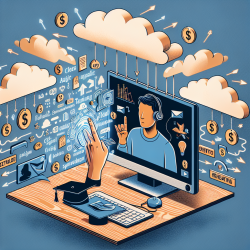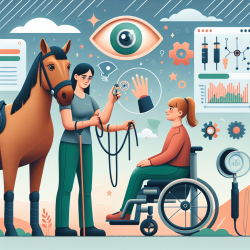The rapid evolution of telepractice offers unprecedented opportunities for speech-language pathologists (SLPs) to enhance their practice, particularly in the realm of dysphagia management. The research article "Tele-Dysphagia Management: An Opportunity for Prevention, Cost-Savings and Advanced Training" by Coyle (2012) underscores the critical need for innovative approaches to address the increasing incidence of dysphagia, especially in underserved areas.
Dysphagia, a swallowing disorder, poses significant risks, including aspiration pneumonia (AP), which can dramatically reduce the quality and likelihood of survival, particularly in stroke patients. The incidence of AP has reached alarming levels, and its management is crucial for patient outcomes and healthcare cost containment. The study by Coyle (2012) presents compelling evidence that tele-dysphagia management can play a pivotal role in addressing these challenges.
Key Insights from the Research
- Prevention and Cost-Savings: The implementation of tele-dysphagia management has the potential to prevent hospital admissions for AP and reduce the length of hospital stays, resulting in substantial cost savings. Even modest reductions in AP cases can save the US healthcare system hundreds of millions of dollars annually.
- Enhanced Training: Telepractice allows for the collaboration between primary clinicians and remote dysphagia experts. This not only elevates the quality of patient care but also provides ongoing, advanced training for primary clinicians, enhancing their expertise through real-time case management consultations.
- Feasibility and Accessibility: Technological advancements have made remote dysphagia consultations feasible and accessible, bridging the gap between expert dysphagia clinicians and patients in underserved areas.
Implementing Tele-Dysphagia Management in Practice
To leverage the benefits of tele-dysphagia management, practitioners should consider the following steps:
- Invest in Technology: Ensure that your practice is equipped with the necessary telecommunication tools to facilitate remote consultations. This includes high-quality video conferencing equipment and secure data sharing platforms.
- Build Collaborations: Establish partnerships with dysphagia experts who can provide remote consultations and training. This can be facilitated through professional networks and specialized training programs.
- Develop Protocols: Create standardized protocols for tele-dysphagia consultations to ensure consistency and efficacy. These protocols should be informed by empirical data and best practices in the field.
- Continuous Learning: Engage in continuous professional development to stay abreast of the latest research and advancements in tele-dysphagia management. This can include attending workshops, webinars, and pursuing advanced certifications.
Encouraging Further Research
While the current evidence is promising, further research is essential to optimize tele-dysphagia management. Practitioners are encouraged to contribute to the body of knowledge by participating in research studies, sharing case studies, and collaborating with academic institutions.
To read the original research paper, please follow this link: Tele-Dysphagia Management: An Opportunity for Prevention, Cost-Savings and Advanced Training










